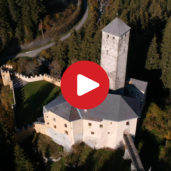Monguelfo, the main village of the eponymous municipality, is situated at the entrance to the Val Casies
Image gallery: Monguelfo
The village of Monguelfo lies at 1,087 m a.s.l. in the central part of the Val Pusteria and has 1,500 inhabitants. Several historical findings from the Bronze Age place the first settlements of this area in his historical context. No rests from the Roman castle and its settlement have survived to this day and the only remain of that historical period is the Roman path (Römerweg) to Dobbiacco.
The famous Castel Monguelfo dates back to the 13th century and overlooks the village from a rock with three steep sides. In summer the castle hosts different exhibitions and concerts. Other attractions you shouldn't miss are the monument and the birthplace of Paul Troger, one of the most well-known exponents of late Baroque. Some of his masterpieces can be admired throughout the village: three of his artworks decorate the altar of the parish church and another one can be found at the seat of the Raiffeisenkasse Welsberg bank.
Monguelfo is embedded in nature and provides fantastic panoramic views of the Dolomites. This destination is highly appreciated by people looking for relaxing holidays in a quiet and natural environment. The municipality is directly connected to the Val Pusteria cycle path which runs across the whole valley and ends in Lienz in East Tyrol. On your way back you can take the train. In winter besides the skiing area of Plan de Corones with its ski lifts starting in the vicinity of Monguelfo, winter sports lovers can have fun on the 40 kilometres of cross-country ski tracks of the Val Casies.
Interesting: Monguelfo was the favourite holiday destination of the Austrian poet Hugo von Hofmannsthal and the Austrian doctor Arthur Schnitzler.


































